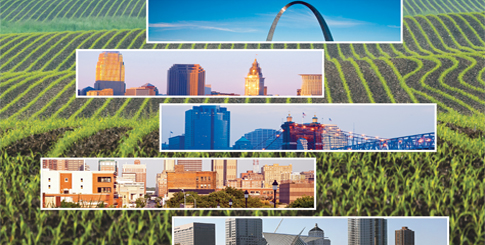BrightFarms, which targets major metropolitan areas, has greenhouses near New York City, Chicago, and Washington, DC, catering to restaurants and retailers. It also has a greenhouse in Ohio, with a 172,000-square-foot structure in Wilmington, northeast of Cincinnati.
Iowa, too, is jumping on the protected agriculture bandwagon. “One of the most recent, big changes I see in produce is receivers here developing a solid homegrown program,” comments DeMatteis. “Even here in Iowa, we see more growers with greenhouses. Consumers want more of that perceived homegrown taste.”
R is for Retail
Food retail competition continues to be cutthroat in the Corn Belt’s major cities, as additional stores pop up and new chains invade the area. “Brick-and-mortar retail seems to be overbuilt already,” observes Maglio in Milwaukee, “with many more locations on the drawing board.” Despite the seeming saturation, there is differentiation as many of the new retail locations are smaller-footprint stores in redeveloped downtowns. Ongoing development has attracted the highly coveted millennial shopper, especially in Cleveland, Indianapolis, and Milwaukee.
“Downtown Indianapolis is just booming,” enthuses Rocky Ray, partner at Ray & Mascari, Inc. in Indy. “Whether it be empty nesters, Baby Boomers, or millennials, we’re just seeing lots of people moving into downtown.”
Cincinnati continues growing into the northern region of Kentucky, and the area has seen both foodservice and fresh-cut business growth. Des Moines keeps blooming as well, into nearby suburbs.
St. Louis, it seems, may be the only city of the six experiencing lukewarm growth; but a huge redevelopment project is progressing in its north, anchored by a new national agency.
And with new housing or retail developments come supermarkets catering to every income level. Discounters—like Aldi, Save-a-Lot, and Kroger’s Ruler banner—have gained market share in the Midwest, challenging Walmart, other chains, and independents. Smaller specialty formats, like Colorado-based Lucky’s, have moved in too.
Supercenters may be slimming down somewhat, but are still opening. Meijer, based in Grand Rapids, MI, continues its expansion, with seven new supercenters in 2017 including two in Indianapolis and three in Wisconsin.
Smaller chains and independents also remain active, with some expanding like Sendik’s in Milwaukee. “Costco now has a presence, Fresh Thyme has recently arrived, Walmart continues to thrive and Sendik’s keeps expanding,” observes Maglio. “All good for the consumer, but potentially too much dilution of dollar-per-square-foot revenue generation for vendors,” he says.



